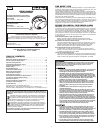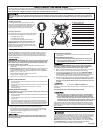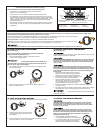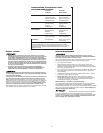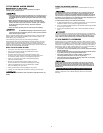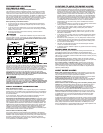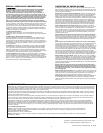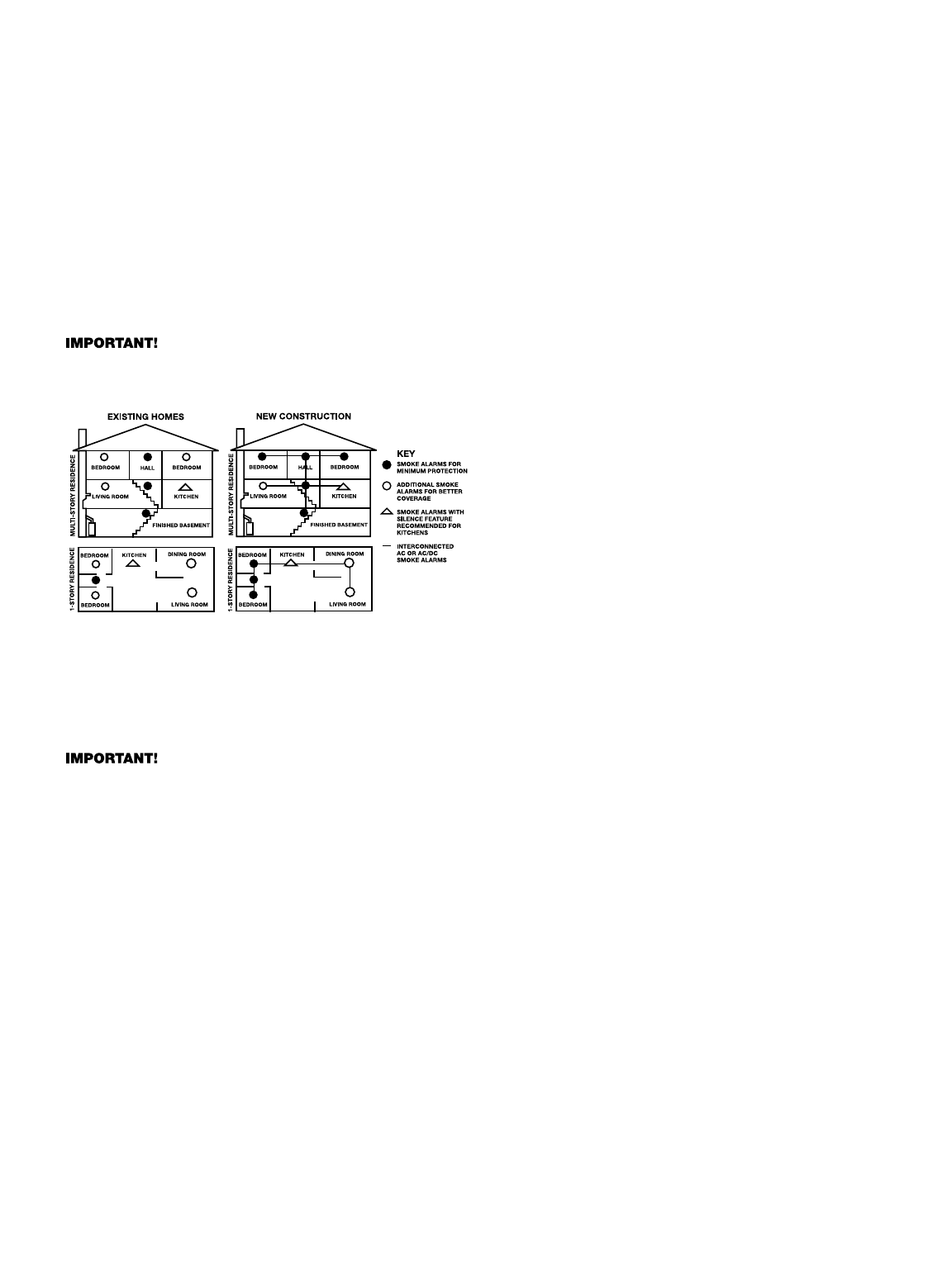
6
RECOMMENDED LOCATIONS
FOR SMOKE ALARMS
Installing Smoke Alarms in Single-Family Residences
The National Fire Protection Association (NFPA), recommends one Smoke
Alarm on every floor, in every sleeping area, and in every bedroom. In new
construction, the Smoke Alarms must be AC powered and interconnected.
See “Agency Placement Recommendations” for details. For additional cover-
age, it is recommended that you install a Smoke Alarm in all rooms, halls,
storage areas, finished attics, and basements, where temperatures normally
remain between 40˚F (4˚C) and 100˚F (38˚C). Make sure no door or other
obstruction could keep smoke from reaching the Smoke Alarms.
More specifically, install Smoke Alarms:
• On every level of your home, including finished attics and basements.
• Inside every bedroom, especially if people sleep with the door partly or
completely closed.
• In the hall near every sleeping area. If your home has multiple sleeping
areas, install a unit in each. If a hall is more than 40 feet long (12 meters),
install a unit at each end.
• At the top of the first-to-second floor stairway, and at the bottom
of the basement stairway.
Specific requirements for Smoke Alarm installation vary from state to state
and from region to region. Check with your local Fire Department for current
requirements in your area.
It is recommended AC or AC/DC units be inter-
connected for added protection.
INSTALLING SMOKE ALARMS IN MOBILE HOMES & RVS
For minimum security install one Smoke Alarm as close to each sleeping area as
possible. For more security, put one unit in each room. Many older mobile homes
(especially those built before 1978) have little or no insulation. If your mobile
home is not well insulated, or if you are unsure of the amount of insulation, it is
important to install units on inside walls only. Smoke Alarms should be installed
where temperatures normally remain between 40˚F (4˚C) and 100˚F (38˚C).
WARNING: Test units used in RVs after the vehicle has been in storage,
before every trip, and once a week while in use. Failure to test units used
in RVs as described may remove your protection.
This equipment should be installed in accordance with NFPA (National Fire
Protection Association) 72 and
101. National Fire Protection Association,
One Batterymarch Park, Quincy, MA 02269-9101. Additional local building and
regulatory codes may apply in your area. Always check compliance require-
ments before beginning any installation.
This model is not RV listed with
Underwriters Laboratories Inc.
AGENCY PLACEMENT RECOMMENDATIONS
NFPA 72 (National Fire Code)
Smoke Alarms shall be installed in each separate sleeping room, outside each
sleeping area in the immediate vicinity of the bedrooms and on each additional
story of the family living unit, including basements and excluding crawl spaces
and unfinished attics.
In new construction, Alarms shall be so arranged that operation of any one
Alarm shall cause the operation of all Alarms within the dwelling.
Smoke Detection-Are More Smoke Alarms Desirable?
The required number
of Smoke Alarms might not provide reliable early warning protection for those
areas separated by a door from the areas protected by the required Smoke
Alarms. For this reason, it is recommended that the householder consider the
use of additional Smoke Alarms for those areas for increased protection. The
additional areas include the basement, bedrooms, dining room, furnace room,
utility room, and hallways not protected by the required Smoke Alarms. The
installation of Smoke Alarms in kitchens, attics (finished or unfinished), or
garages is not normally recommended, as these locations occasionally experi-
ence conditions that can result in improper operation.
California State Fire Marshal (CSFM)
Early warning detection is best achieved by the installation of fire detection
equipment in all rooms and areas of the household as follows: A Smoke Alarm
installed in each separate sleeping area (in the vicinity, but outside bedrooms),
and Heat or Smoke Alarms in the living rooms, dining rooms, bedrooms,
kitchens, hallways, finished attics, furnace rooms, closets, utility and storage
rooms, basements, and attached garages.
LOCATIONS TO AVOID FOR SMOKE ALARMS
For best performance, AVOID installing Smoke Alarms in these areas:
• Where combustion particles are produced. Combustion particles form
when something burns. Areas to avoid include poorly ventilated kitchens,
garages, and furnace rooms. Keep units at least 20 feet (6 meters) from
the sources of combustion particles (stove, furnace, water heater, space
heater) if possible. In areas where a 20-foot distance is not possible – in
modular, mobile, or smaller homes, for example – it is recommended the
Smoke Alarm be placed as far from these fuel-burning sources as possi-
ble. The placement recommendations are intended to keep these Alarms
at a reasonable distance from a fuel-burning source, and thus reduce
“unwanted” alarms. Unwanted alarms can occur if a Smoke Alarm is
placed directly next to a fuel-burning source. Ventilate these areas as
much as possible.
• In air streams near kitchens. Air currents can draw cooking smoke into the
sensing chamber of a Smoke Alarm near the kitchen.
• In very damp, humid or steamy areas, or directly near bathrooms with
showers. Keep units at least 10 feet (3 meters) away from showers,
saunas, dishwashers, etc.
• Where the temperatures are regularly below 40˚F (4˚ C) or above 100˚ F
(38˚ C) including unheated buildings, outdoor rooms, porches, or unfin-
ished attics or basements.
• In very dusty, dirty, or greasy areas. Do not install a Smoke Alarm directly
over the stove or range. Clean a laundry room unit frequently to keep it
free of dust or lint.
• Near fresh air vents, ceiling fans, or in very drafty areas. Drafts can blow
smoke away from the unit, preventing it from reaching sensing chamber.
• In insect infested areas. Insects can clog openings to the sensing cham-
ber and cause unwanted alarms.
• Less than 12 inches (305 mm) away from fluorescent lights. Electrical
“noise” can interfere with the sensor.
• In “dead air” spaces. “Dead air” spaces may prevent smoke from reaching
the Smoke Alarm.
AVOIDING DEAD AIR SPACES
“Dead air” spaces may prevent smoke from reaching the Smoke Alarm. To
avoid dead air spaces, follow the installation recommendations below.
On ceilings, install Smoke Alarms as close to the center of the ceiling as pos-
sible. If this is not possible, install the Smoke Alarm at least 4 inches (102 mm)
from the wall or corner.
For wall mounting (if allowed by building codes), the top edge of Smoke
Alarms should be placed between 4 inches (102 mm) and 12 inches (305 mm)
from the wall/ceiling line, below typical “dead air” spaces.
On a peaked, gabled, or cathedral ceiling, install the first Smoke Alarm
within 3 feet (0.9 meters) of the peak of the ceiling, measured horizontally.
Additional Smoke Alarms may be required depending on the length, angle,
etc. of the ceiling's slope. Refer to NFPA 72 for details on requirements for
sloped or peaked ceilings.
ABOUT SMOKE ALARMS
Battery (DC) operated Smoke Alarms: Provide protection even when elec-
tricity fails, provided the batteries are fresh and correctly installed. Units are
easy to install, and do not require professional installation.
AC powered Smoke Alarms: Can be interconnected so if one unit senses
smoke, all units alarm. They do not operate if electricity fails.
AC with battery (DC) back-up: will operate if electricity fails, provided the
batteries are fresh and correctly installed. AC and AC/DC units must be
installed by a qualified electrician.
Smoke Alarms for Solar or Wind Energy users and battery backup power
systems: AC powered Smoke Alarms should only be operated with true or
pure sine wave inverters. Operating this Smoke Alarm with most battery-
powered UPS (uninterruptible power supply) products or square wave or
“quasi sine wave” inverters will damage the Alarm. If you are not sure about
your inverter or UPS type, please consult with the manufacturer to verify.
Smoke Alarms for the hearing impaired: Special purpose Smoke Alarms
should be installed for the hearing impaired. They include a visual alarm and
an audible alarm horn, and meet the requirements of the Americans With
Disabilities Act. These units can be interconnected so if one unit senses
smoke, all units alarm.
All these Smoke Alarms are designed to provide early warning of fires if located,
installed and cared for as described in the user’s manual, and if smoke reaches
the Alarm. If you are unsure which type of unit to install, refer to NFPA (National
Fire Protection Association) 72 (National Fire Alarm Code) and NFPA 101 (Life
Safety Code). National Fire Protection Association, One Batterymarch Park,
Quincy, MA 02269-9101.
Local building codes may also require specific units
in new construction or in different areas of the home.



